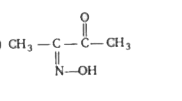PhCHO+(CH3CO)2O(1)CH3COONa−−−−−−−−−−→(2)hydrolysis,ΔAHBr−−→BB
The product B is
PhCH=CHCH2Br
PhC∣BrH−CH2−COOH
PhCH2CH(Br)COOH
PhCH=CH−COBr
The correct Answer is:B
To solve the problem step by step, we need to analyze the reactions taking place between the given compounds.
Step 1: Identify the Reactants
The reactants in the reaction are:
- PhCHO: This is benzaldehyde (or benzyldehyde).
- (CH₃CO)₂O: This is acetic anhydride.
Step 2: Understand the Reaction Conditions
The reaction is facilitated by:
- CH₃COONa: This is sodium acetate, which acts as a catalyst.
- Hydrolysis: This indicates that water will be involved in the reaction, leading to the formation of a product.
Step 3: Perform the Reaction (Perkin Condensation)
The reaction between benzaldehyde and acetic anhydride in the presence of sodium acetate is an example of the Perkin condensation. This reaction leads to the formation of a compound known as cinnamic acid.
The structure of cinnamic acid can be represented as:
- C6H5-CH=CH-COOH
Step 4: Identify Product A
After the first step, the product A formed is cinnamic acid (C6H5-CH=CH-COOH).
Step 5: Second Reaction with HBr
In the second part of the reaction, cinnamic acid reacts with HBr. This reaction involves the addition of HBr across the double bond of cinnamic acid, following Markovnikov's rule.
Step 6: Form Product B
The addition of HBr to cinnamic acid results in the formation of 3-bromo-3-phenylpropanoic acid. The structure can be represented as:
- C6H5-CHBr-CH2-COOH
Step 7: Identify Product B
Thus, the final product B is 3-bromo-3-phenylpropanoic acid.
Conclusion
The final answer to the question is that the product B is 3-bromo-3-phenylpropanoic acid.
---
The reactants in the reaction are:
- PhCHO: This is benzaldehyde (or benzyldehyde).
- (CH₃CO)₂O: This is acetic anhydride.
The reaction is facilitated by:
- CH₃COONa: This is sodium acetate, which acts as a catalyst.
- Hydrolysis: This indicates that water will be involved in the reaction, leading to the formation of a product.
The reaction between benzaldehyde and acetic anhydride in the presence of sodium acetate is an example of the Perkin condensation. This reaction leads to the formation of a compound known as cinnamic acid.
- C6H5-CH=CH-COOH
After the first step, the product A formed is cinnamic acid (C6H5-CH=CH-COOH).
In the second part of the reaction, cinnamic acid reacts with HBr. This reaction involves the addition of HBr across the double bond of cinnamic acid, following Markovnikov's rule.
The addition of HBr to cinnamic acid results in the formation of 3-bromo-3-phenylpropanoic acid. The structure can be represented as:
- C6H5-CHBr-CH2-COOH
Thus, the final product B is 3-bromo-3-phenylpropanoic acid.
The final answer to the question is that the product B is 3-bromo-3-phenylpropanoic acid.
Topper's Solved these Questions
- CARBONYL COMPOUNDS (ALDEHYDES & KETONES ) & CARBOXYLIC ACID BOOK - RESONANCE ENGLISHCHAPTER - CARBONYL COMPOUNDS (ALDEHYDES & KETONES ) & CARBOXYLIC ACID EXERCISE - PART- IV
13 Videos
- CARBONYL COMPOUNDS (ALDEHYDES & KETONES ) & CARBOXYLIC ACID BOOK - RESONANCE ENGLISHCHAPTER - CARBONYL COMPOUNDS (ALDEHYDES & KETONES ) & CARBOXYLIC ACID EXERCISE - Exercise-3
1 Videos
- CARBONYL COMPOUNDS (ALDEHYDES & KETONES ) & CARBOXYLIC ACID BOOK - RESONANCE ENGLISHCHAPTER - CARBONYL COMPOUNDS (ALDEHYDES & KETONES ) & CARBOXYLIC ACID EXERCISE - Exercise-2 Part-I
1 Videos
- BIOMOLECULES & POLYMERBOOK - RESONANCE ENGLISHCHAPTER - BIOMOLECULES & POLYMEREXERCISE - ORGANIC CHEMISTRY(Biomolecules & Polymer)
34 Videos
- CHEMICAL KINETICSBOOK - RESONANCE ENGLISHCHAPTER - CHEMICAL KINETICSEXERCISE - PHYSICAL CHEMITRY (CHEMICAL KNIETICS & RADIOACTIVITY)
49 Videos
Similar Questions
Knowledge Check
CH3CH2−O∣∣C−CH3NaNO2−−−−→HCl, Major product of this reaction is :
ACH3C∣NOH−O∣∣C−CH3BCH3−CH2−O∣∣C−CH=N−OHC D
D
CH3CH2NH2(CH3CO)2−−−−−−→ΔA+B, (A) and (B) are
View SolutionCH2−CONH2|CH2−CONH2P2O5−−→Δ(P)H3O⊕−−−→Δ(Q)
The product (Q) is
View Solution (i)CH3CHO−−−−−−−→(ii)H3O+ (A) HBr−−→ (B)
(i)CH3CHO−−−−−−−→(ii)H3O+ (A) HBr−−→ (B)
The compounds (A) and (B)
View SolutionRCH=CH2(1)O3−−−−−−−−−−−−→(2)H2O\(Zn)(A)H2O−−−−−−→LiAIH4(B)
Product (B) is
View SolutionIn the reaction sequences
2CH3CHOOH−−−→AΔ−−→B the product B is
View SolutionIn the given reaction the products is :
CH3−CH2−C∣∣O−OCH3+CH3−C∣∣O−OCH3(1)CH3OΘNa+−−−−−−−−−−→(2)CH3OHoversert(H2O)−−→Δ product
View SolutionCH2OH∣ C=O∣ (CHOH)3∣ CH2OHNaBH4−−−−→A+B
Fructose
The product A and B in the a above reaction are not
View Solution
